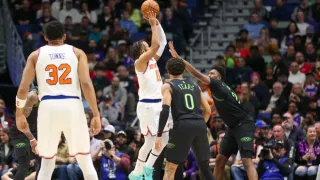February 17, 2021
After Coming Out as Trans, WWE Star Gabbi Tuft Opens Up About Love Life with Wife
Kilian Melloy READ TIME: 2 MIN.
Former WWE star Gabbi Tuft posted a sweet Valentine's Day message in which she reiterated her deep love for her wife following her coming out as transgender earlier this month - even though sex between the couple is "on pause" for now, reports U.K. newspaper the Daily Mail.
Tuft, 42, and her wife Priscilla Victoria, 39, have been married for 18 years, but they have been together for 22 years. In a moving Valentine's Day Instagram post, Tuft put up a photo of herself and Victoria, and asked, "When you look with your eyes, what do you see within this photo?"
"Do you see two people that have shared 22 Valentine's Days together?" the post added. "Do you see the knowing in both our eyes that even though this Valentine's Day may look somewhat different than others past, there is no shortness of love in the air?"
The post went on to describe love as a phenomenon that "transcends multiple planes of existence" and "exists far beyond married couples, lovers, and family".
"Imagine the possibilities if we saw each person we encounter with our hearts, before we saw them with our eyes," the post added.
Tuft and Victoria commented on their post-coming out relationship status in the third episode of Her PodBean Podcast, titled "Is G Gay?," with Victoria, a Reiki practitioner, saying that the "energy" between them had "shifted," and adding, "The thought of making love to a female just isn't my thing."
However, Victoria added, "There are no words to describe how much I love this human being and I don't care whether this sweet individual is presenting male or female, because the soul is androgynous."
Sex or no sex, their relationship is forever, Victoria told listeners. "We understand things are going to change, we don't know how they're going to change, but we know we're desperately intertwined for life."
"Whether that looks like marriage, awesome," Victoria went on to say. "Whether that looks like roommates, neighbors, we don't know. But we know that we are lifers, we know that we adore each other, we will always be twin flames, we love each other."
As previously reported at EDGE, Tuft came out in a lengthy Instagram post earlier this month.
"This is me," Tuft wrote Feb. 4 in text that accompanied a photo of herself with long hair and dressed in women's attire. "Unashamed, unabashedly me. This is the side of me that has hidden in the shadows, afraid and fearful of what the world would think; afraid of what my family, friends, and followers would say or do.
"I am no longer afraid and I am no longer fearful," Tuft added. "I can now say with confidence, that I love myself for WHO I am."






